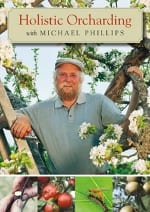 with Michael Phillips
with Michael Phillips
Chelsea Green Publishing, 2013
Reviewed by Penny Lewis
Generally when you’ve read and enjoyed a book, the movie version is a disappointment. But the recently released DVD, Holistic Orcharding, from Michael Phillips, author of The Holistic Orchard, is a wonderful exception. This five-hour video is subdivided into twenty-one sections that follow Phillips through a full year in his orchard. Be warned, don’t plan to watch this video while casually munching a bowl of popcorn. It is so densely packed with valuable information that you’ll be reaching for the remote’s pause button in order to take notes and not miss a single gem that Phillips has to share.
Throughout the DVD, Phillips educates and inspires the viewer with a comprehensive array of orchard management topics that are organized around the growing year. At first glance, there may seem to be redundant information, for example soil topics occur in several segments, but the organization effectively conveys to the orchardist that some important orchard practices are indeed year-round endeavor. Soil must be monitored and adjusted at appropriate times throughout the year, and proper timing of soil adjustments can reap maximum benefits.
Here are a few of the video highlights:
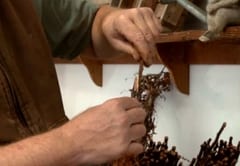 The Bench Grafting segment begins with a comprehensive lesson in starting your own fruit trees using a variety of grafting methods. The instructions show how to prepare and care for the graft and delve into specifics such as root stock selection, storage temperatures, and tools.
The Bench Grafting segment begins with a comprehensive lesson in starting your own fruit trees using a variety of grafting methods. The instructions show how to prepare and care for the graft and delve into specifics such as root stock selection, storage temperatures, and tools.
Tree Planting takes the viewer out into the orchard to plant fruit trees, but before planting the tree, Phillips explains the components of a successful soil ecosystem for a healthy orchard and discusses soil testing, acidity levels, soil amendments, and weed management.
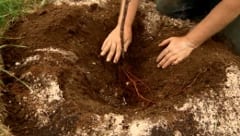 In this section, Phillips introduces the viewer to the planting circle and demonstrates how to create a balanced nutritional profile with slow-release, organic fertilizers. He also discusses use of the comfrey circle as a weed suppression technique.
In this section, Phillips introduces the viewer to the planting circle and demonstrates how to create a balanced nutritional profile with slow-release, organic fertilizers. He also discusses use of the comfrey circle as a weed suppression technique.
The importance of keeping the tree circle open during the first few years of fruit tree development is explained and demonstrated in the segment on Young Trees. Phillips explains the pea stone approach that he uses to both suppress weeds and facilitate checking the trunk for insects later in the season. Cultivating and applying nitrogen is part of the spring orchard management for young fruit trees, and in this section of the video, Phillips also provides specific recommendations for nitrogen sources and application rates.
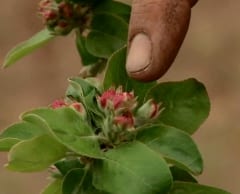 To schedule orchard care, rather than relying on calendar dates, which vary from region to region, Phillips references the stages of bud development. In the video segment Bud Stages, he defines the four categories of development that he uses as visual cues to differentiate the pace of spring development. The visual cues are just one part of a complex process that includes analysis of degree days and the relationship of temperature to fungal development in an orchard. By relating the infection period of such major orchard threats as apple scab fungus to bud stages, Phillips helps the orchardist to target the 1-2 week window when it is critical to build the immune function and to increase competitive colonization on the tree.
To schedule orchard care, rather than relying on calendar dates, which vary from region to region, Phillips references the stages of bud development. In the video segment Bud Stages, he defines the four categories of development that he uses as visual cues to differentiate the pace of spring development. The visual cues are just one part of a complex process that includes analysis of degree days and the relationship of temperature to fungal development in an orchard. By relating the infection period of such major orchard threats as apple scab fungus to bud stages, Phillips helps the orchardist to target the 1-2 week window when it is critical to build the immune function and to increase competitive colonization on the tree.
Once spring arrives, Phillips demonstrates Bark Grafting techniques on a tree in his orchard where he has grafted 24 different varieties of apples on a single tree. He provides detail instructions that include tools and techniques for successfully grafting on established trees.
Training and Limb Spreading provides instruction on how to achieve optimum form for fruit trees. Phillips explains how to train young fruit trees in order to create a strong limb structure with the most desirable branching angles. This section demonstrates the tools and techniques used for training young trees to optimize the form early.
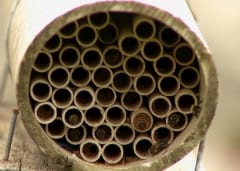 Throughout this video, Phillips demonstrates a remarkable understanding of both the horticulture and broader ecosystem of the orchard. But it is in the Pollination segment that his love of all creatures, great and small, becomes evident. In this segment Phillips demonstrates several techniques that he uses to encourage pollination in the orchard. These techniques include tree spacing, planting other pollinator-friendly plants in and around the orchard, and creating structures to encourage blue orchard bees (Osmia lignaria), a solitary bee that is an orchard’s most effective pollinator. Phillips explains that 200 female blue orchard bees can pollinate an acre of orchard; it takes 40,000 to 60,000 honeybees to pollinate the same area.
Throughout this video, Phillips demonstrates a remarkable understanding of both the horticulture and broader ecosystem of the orchard. But it is in the Pollination segment that his love of all creatures, great and small, becomes evident. In this segment Phillips demonstrates several techniques that he uses to encourage pollination in the orchard. These techniques include tree spacing, planting other pollinator-friendly plants in and around the orchard, and creating structures to encourage blue orchard bees (Osmia lignaria), a solitary bee that is an orchard’s most effective pollinator. Phillips explains that 200 female blue orchard bees can pollinate an acre of orchard; it takes 40,000 to 60,000 honeybees to pollinate the same area.
 The cornerstone of Phillips’ orchard management is his technique for building immune function and increasing competitive colonization. He accomplishes this using his Four Holistic Sprays of spring. By applying these four sprays such that they straddle the primary infection period, he maximizes their benefits. Phillips first explains the timing for the sprays using the four bud stages defined earlier in the video. He then offers detail on the ingredients in each of the four sprays, powerful nutritional brews that support beneficial fungi that stimulate the immune function of a tree.
The cornerstone of Phillips’ orchard management is his technique for building immune function and increasing competitive colonization. He accomplishes this using his Four Holistic Sprays of spring. By applying these four sprays such that they straddle the primary infection period, he maximizes their benefits. Phillips first explains the timing for the sprays using the four bud stages defined earlier in the video. He then offers detail on the ingredients in each of the four sprays, powerful nutritional brews that support beneficial fungi that stimulate the immune function of a tree.
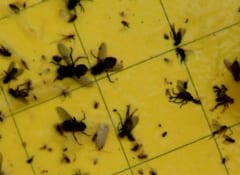 The Orchard Pests segment is enough to scare anyone away from ever planting a fruit tree as Phillips goes into great detail explaining a wide variety of potential orchard threats. But with a careful balance of science and common-sense observation, Phillips makes the subject accessible as he explains the proven non-chemical techniques for dealing with each type of pest. Phillips explains how to mix and apply kaolin clay, one of the most successful barrier sprays available to the organic orchardist, in a “light touch” approach for best results. He also explains the use of trap trees to attract pests that can then be controlled at ground level, using ducks or chickens for example.
The Orchard Pests segment is enough to scare anyone away from ever planting a fruit tree as Phillips goes into great detail explaining a wide variety of potential orchard threats. But with a careful balance of science and common-sense observation, Phillips makes the subject accessible as he explains the proven non-chemical techniques for dealing with each type of pest. Phillips explains how to mix and apply kaolin clay, one of the most successful barrier sprays available to the organic orchardist, in a “light touch” approach for best results. He also explains the use of trap trees to attract pests that can then be controlled at ground level, using ducks or chickens for example.
“Get inside your trees,” instructs Phillips, to observe Sunlight Penetration during the summer and ensure that shoots, spurs, and fruit receive no less than 30% of available sunlight. Though not typically a pruning season, he recommends removal of vertical shoots in summer to increase sunlight penetration. Summer pruning does not produce the same vegetative response as spring pruning and instead opens the tree for better fruit color at harvest time.
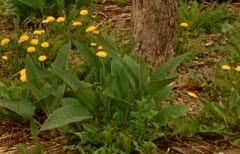 Building healthy soil is key to a successful crop and throughout the video, Phillips returns to this foundation of the orchard. In the Healthy Understory segment, Phillips describes his spring application of ramial wood chips under his fruit trees. He makes ramial chips from wood acquired from the upper portion of trees cut for firewood or cleared in areas for orchard expansion. These wood chips provide a good source of soluble lignans stored as minerals in the buds, twigs, and cambium of the bark.
Building healthy soil is key to a successful crop and throughout the video, Phillips returns to this foundation of the orchard. In the Healthy Understory segment, Phillips describes his spring application of ramial wood chips under his fruit trees. He makes ramial chips from wood acquired from the upper portion of trees cut for firewood or cleared in areas for orchard expansion. These wood chips provide a good source of soluble lignans stored as minerals in the buds, twigs, and cambium of the bark.
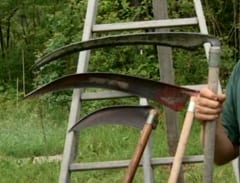 Biological Mowing includes both the timing and tools needed to accomplish limited mowing with maximum benefits in the orchard. Phillips discusses the cycles of feeder root activity, shoot growth, carbon to nitrogen ratio, and the effects on beneficial fungi. He also explains the optimum time for mowing in order to produce a denser root system. He shows various types of scythes, explains how each is used, demonstrates scything techniques, and provides a tool sharpening demonstration.
Biological Mowing includes both the timing and tools needed to accomplish limited mowing with maximum benefits in the orchard. Phillips discusses the cycles of feeder root activity, shoot growth, carbon to nitrogen ratio, and the effects on beneficial fungi. He also explains the optimum time for mowing in order to produce a denser root system. He shows various types of scythes, explains how each is used, demonstrates scything techniques, and provides a tool sharpening demonstration.
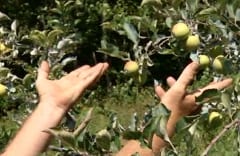 For a new orchardist, intentionally removing perfectly good looking apples, peaches, or pears seems a waste. But Phillips covers Thinning Fruit in a manner that is easy to understand and removes the uncertainty of this step of orchard care. Phillips explains the science behind thinning this year to ensure large fruit, but also to improve production of flowers and fruit the following year.
For a new orchardist, intentionally removing perfectly good looking apples, peaches, or pears seems a waste. But Phillips covers Thinning Fruit in a manner that is easy to understand and removes the uncertainty of this step of orchard care. Phillips explains the science behind thinning this year to ensure large fruit, but also to improve production of flowers and fruit the following year.
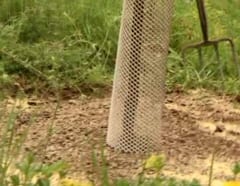 Phillips explains not only the basics of Soil Testing in this segment, but also the timing of late summer testing and application of soil amendments to produce maximum benefit. Phillips demonstrates the technique for taking drip line samples, which he refers to as “where the action is,” and offers more soil science. He explains tree growth cycles, soil structure, ideal PH levels and how to adjust the PH, cation-exchange capacity value and how to influence the soil’s ability to hold nutrients, as well as how to correct nutrient levels. This segment is dense, but again Phillips is an accomplished teacher. By layering eco-system concepts throughout the video, the viewer by now understands the complex relationships of living soil diversity and the symbiotic organisms which feed the tree and ultimately protect the orchard from pests.
Phillips explains not only the basics of Soil Testing in this segment, but also the timing of late summer testing and application of soil amendments to produce maximum benefit. Phillips demonstrates the technique for taking drip line samples, which he refers to as “where the action is,” and offers more soil science. He explains tree growth cycles, soil structure, ideal PH levels and how to adjust the PH, cation-exchange capacity value and how to influence the soil’s ability to hold nutrients, as well as how to correct nutrient levels. This segment is dense, but again Phillips is an accomplished teacher. By layering eco-system concepts throughout the video, the viewer by now understands the complex relationships of living soil diversity and the symbiotic organisms which feed the tree and ultimately protect the orchard from pests.
In northern New England where Phillips maintains his orchard, Summer Insects include the apple maggot fly. In this segment, he explains the life cycle of this and other summer insects and explains how to monitor for them and how to easily create an apple trap. Phillips also discusses aphids and borers that emerge in summer and discusses how beneficial insects encouraged earlier in the year will help to combat these insects. This segment also includes Phillips’ recommendations for summer herbal sprays.
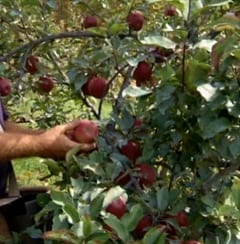 As summer ends, the orchardist knows that Harvest will soon follow. Phillips demonstrates how to determine peak time for harvesting, picking techniques, ladder types and safe use, as well as how to manage the harvest by understanding which apples will keep longest on the trees. In this segment, Phillips also explains what causes drops during the season and suggests management strategies. At harvest, Phillips also takes time to observe apple aesthetic characteristics to assess the success of pest treatments earlier in the year.
As summer ends, the orchardist knows that Harvest will soon follow. Phillips demonstrates how to determine peak time for harvesting, picking techniques, ladder types and safe use, as well as how to manage the harvest by understanding which apples will keep longest on the trees. In this segment, Phillips also explains what causes drops during the season and suggests management strategies. At harvest, Phillips also takes time to observe apple aesthetic characteristics to assess the success of pest treatments earlier in the year.
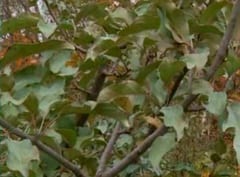 Late Fall care includes an orchard inspection to assess tree health and to look for early signs of disease. Phillips discusses the orchard growth stage that occurs in the fall and determines healthy bud growth the following spring. Late fall is another time to enhance soil nutrients. Here again Phillips looks through the lens of soil biology as he explains how to add organic soil amendments in order to bring the soil into proper balance. Late fall encompasses leaf drop, and Phillips discusses leaf management in the orchard, including steps to enhance decomposition and prevent disease.
Late Fall care includes an orchard inspection to assess tree health and to look for early signs of disease. Phillips discusses the orchard growth stage that occurs in the fall and determines healthy bud growth the following spring. Late fall is another time to enhance soil nutrients. Here again Phillips looks through the lens of soil biology as he explains how to add organic soil amendments in order to bring the soil into proper balance. Late fall encompasses leaf drop, and Phillips discusses leaf management in the orchard, including steps to enhance decomposition and prevent disease.
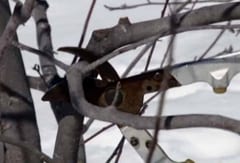 Phillips begins Winter Pruning in late March in his area, to minimize the threat of winter injury. His goal is to avoid pruning that will be followed by severe freezing temperatures within 7 to 10 days. Phillips explains the various goals of pruning including, most importantly, sunlight penetration. Phillips teaches how to determine where next year’s fruit will come from in different fruit trees, a key factor in determining what to prune and what not to prune. This pruning class also describes how to create proper access to the tree and explains how to use various pruning tools.
Phillips begins Winter Pruning in late March in his area, to minimize the threat of winter injury. His goal is to avoid pruning that will be followed by severe freezing temperatures within 7 to 10 days. Phillips explains the various goals of pruning including, most importantly, sunlight penetration. Phillips teaches how to determine where next year’s fruit will come from in different fruit trees, a key factor in determining what to prune and what not to prune. This pruning class also describes how to create proper access to the tree and explains how to use various pruning tools.
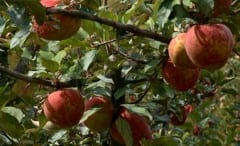 Throughout Holistic Orcharding, Michael Phillips encourages orchardists to be ecosystem thinkers: to pick holistic ingredients that will build healthy soil, to pick organic options instead of chemical fertilizers or chemical pest control, to create habitat that encourage birds and beneficial insects, and to understand how ecosystem decisions affect the delicious fruit picked in the fall. Whether you are considering a single fruit tree or an orchard of your own, I encourage you to make this video your first pick.
Throughout Holistic Orcharding, Michael Phillips encourages orchardists to be ecosystem thinkers: to pick holistic ingredients that will build healthy soil, to pick organic options instead of chemical fertilizers or chemical pest control, to create habitat that encourage birds and beneficial insects, and to understand how ecosystem decisions affect the delicious fruit picked in the fall. Whether you are considering a single fruit tree or an orchard of your own, I encourage you to make this video your first pick.

